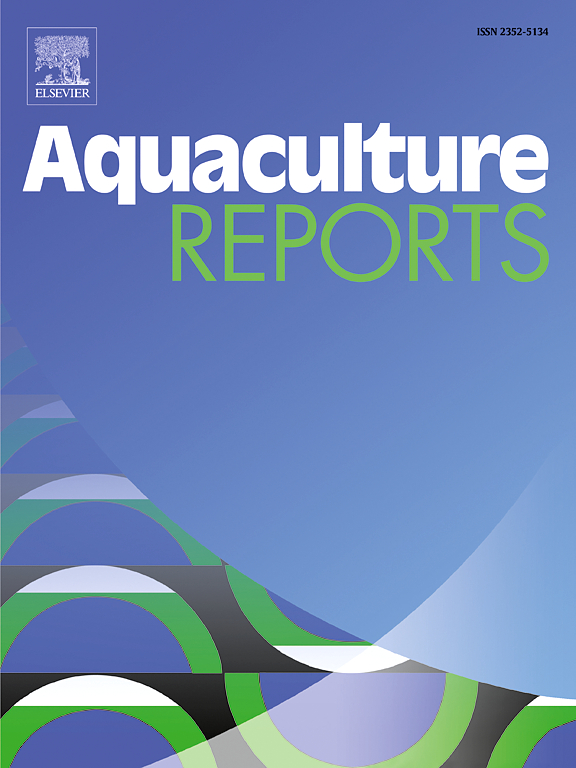综合蛋白质组学和代谢组学分析揭示了锌暴露对凡纳滨对虾肝胰腺的影响:反应机制的见解
IF 3.7
2区 农林科学
Q1 FISHERIES
引用次数: 0
摘要
锌(Zn)是一种微量元素,在环境中浓度升高是有毒的。本研究对凡纳滨对虾(Litopenaeus vannamei)暴露于1 mg/L Zn环境30天后的肝胰腺进行了综合蛋白质组学和代谢组学分析,探讨可能的应答机制。共鉴定出1220个差异表达蛋白(DEPs)(其中上调1083个,下调137个)和574个差异代谢物(DMs)(其中上调149个,下调425个)。为进一步联合分析,对DEPs和DMs进行KEGG富集分析,发现DEPs和DMs与氧化磷酸化(ko00190)、戊糖磷酸途径(ko00030)、花生四烯酸代谢(ko00590)、亚油酸代谢(ko00591)等脂质代谢以及谷胱甘肽代谢(ko00480)等抗氧化系统相关,进一步分析。结果表明,锌暴露限制了ATP的合成和代谢,损害了能量代谢,干扰了代谢物的正常功能,从而抑制了DNA、RNA和蛋白质的合成,影响了抗氧化系统,破坏了脂质代谢,导致细胞内环境的紊乱。综上所述,本研究系统阐述了锌暴露对虾的潜在反应机制,揭示了锌对凡纳米扁豆蛋白和代谢水平的毒性作用,为甲壳类动物免疫防御机制的研究提供了新的见解。本文章由计算机程序翻译,如有差异,请以英文原文为准。
Integrated proteomics and metabolomics analysis reveals the impact of zinc exposure on hepatopancreas from Litopenaeus vannamei: Insights into the response mechanisms
Zinc (Zn) is a trace element that is toxic at elevated concentrations in the environment. In this study, we conducted integrated proteomics and metabolomics analysis on the hepatopancreas in Litopenaeus vannamei after exposed in 1 mg/L Zn for 30 days to investigate the potential response mechanisms. A total of 1220 differentially expressed proteins (DEPs) (of which 1083 were up-regulated and 137 were down-regulated) and 574 differential metabolites (DMs) (of which 149 were up-regulated and 425 were down-regulated) were identified, respectively. For further joint analysis, KEGG enrichment analysis was performed on DEPs and DMs, which showed that DEPs and DMs related to energy metabolism such as oxidative phosphorylation (ko00190), pentose phosphate pathway (ko00030), lipid metabolism such as arachidonic acid metabolism (ko00590), linoleic acid metabolism (ko00591), and antioxidant system such as glutathione metabolism (ko00480), which were further analyzed. The results demonstrated that Zn exposure limited ATP synthesis and metabolism, impaired energy metabolism, interfered with the normal functioning of metabolites, which in turn inhibits the synthesis of DNA, RNA, and proteins, affected the antioxidant system, and disrupted lipid metabolism, leading to disturbances of the intracellular environment. Collectively, this study systemically elaborated the potential mechanisms of shrimp response to Zn exposure, the results revealed the toxic effects of Zn on the protein and metabolic levels of the L. vannamei, provided new insights into the study of crustacean immune defense mechanisms.
求助全文
通过发布文献求助,成功后即可免费获取论文全文。
去求助
来源期刊

Aquaculture Reports
Agricultural and Biological Sciences-Animal Science and Zoology
CiteScore
5.90
自引率
8.10%
发文量
469
审稿时长
77 days
期刊介绍:
Aquaculture Reports will publish original research papers and reviews documenting outstanding science with a regional context and focus, answering the need for high quality information on novel species, systems and regions in emerging areas of aquaculture research and development, such as integrated multi-trophic aquaculture, urban aquaculture, ornamental, unfed aquaculture, offshore aquaculture and others. Papers having industry research as priority and encompassing product development research or current industry practice are encouraged.
 求助内容:
求助内容: 应助结果提醒方式:
应助结果提醒方式:


